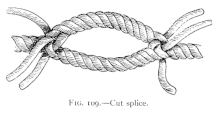

This article needs additional citations for verification. Please help improve this articlebyadding citations to reliable sources. Unsourced material may be challenged and removed.
Find sources: "Rope splicing" – news · newspapers · books · scholar · JSTOR (December 2009) (Learn how and when to remove this message) |

Rope splicinginropework is the forming of a semi-permanent joint between two ropes or two parts of the same rope by partly untwisting and then interweaving their strands. Splices can be used to form a stopper at the end of a line, to form a loop or an eye in a rope, or for joining two ropes together.[1] Splices are preferred to knotted rope, since while a knot typically reduces the strength by 20–40%,[2] a splice is capable of attaining a rope's full strength.[3] However, splicing usually results in a thickening of the line and, if subsequently removed, leaves a distortion of the rope. Most types of splices are used on three-strand rope, but some can be done on 12-strand or greater single-braided rope, as well as most double braids.
While a spliced three-strand rope's strands are interwoven to create the splice, a braided rope's splice is constructed by simply pulling the rope into its jacket.[clarification needed]




Splices are often tapered to make the thicker splice blend into the rest of the line. There are two main types of tapering, the standard and the "West Coast Taper".

Afid is a hand tool made from wood, plastic, or bone and is used in the process of working with rope. A variety of fid diameters are available depending on the size of rope being used. Styles of fid designs include:[10]
Amarlinspike is a tool, usually made of steel and often part of a sailor's pocketknife, which is used to separate strands of rope from one another. They can range in size anywhere from 3 inches (76 mm) to 5 feet (1.5 m) long, with a round or flattened point.[11]
A pulling fid is often used for smaller diameters of braided ropes. Also a Softfid is a great tool when dealing with tightly braided ropes.